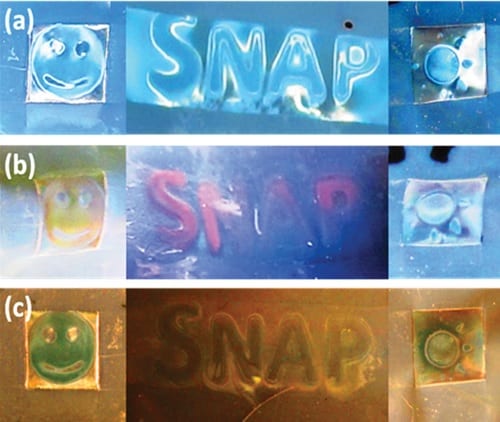Liquid crystal displays (LCD) displays are in use in many electric devices like watches, calculators, mobile phones, and notebook computers. A thin layer of liquid crystal is sandwiched between two electrically conducting plates. By applying electrical signals across the plates, various segments of the liquid crystal are activated, causing changes in their light diffusing or polarizing properties.
That begs the question: isn’t it possible to produce permanent color print in a similar way? A kind of a single tunable ‘ink’ for printing applications that generates all colors.
Recent studies in this area have focused on the use of magnetic fields to form strings of superparamagnetic colloidal particles, which are then fixed in place by UV curing their surrounding matrix. The printing of a range of structural colors has been demonstrated by this technique. However, optical absorption by the magnetic particles, and the need for a ‘wash out’ step of residual structural colors before printing, are the main disadvantages of this technique.
 Now, Benjamin Michaelis and coworkers from the University of Cambridge, the Aberystwyth University, both UK, and the Deutsches Kunststoff-Institut (DKI) in Darmstadt, Germany, presented a tunable method for generating lithographically defined printed structural color. They demonstrated the formation and preservation of tunable crystal structures by ordering of colloids in an alternating electric field and subsequent UV curing of the organic dispersion medium. Without the external stimulus, the polymer particles are distributed randomly in the suspension. This forms a transparent film upon exposure to UV light so that no ‘wash-out’ step is necessary.
Now, Benjamin Michaelis and coworkers from the University of Cambridge, the Aberystwyth University, both UK, and the Deutsches Kunststoff-Institut (DKI) in Darmstadt, Germany, presented a tunable method for generating lithographically defined printed structural color. They demonstrated the formation and preservation of tunable crystal structures by ordering of colloids in an alternating electric field and subsequent UV curing of the organic dispersion medium. Without the external stimulus, the polymer particles are distributed randomly in the suspension. This forms a transparent film upon exposure to UV light so that no ‘wash-out’ step is necessary.
The investigations revealed that in addition to the subjectively vivid colors produced, the samples are visually stable over periods of months to years. The scientists expect the samples to be mechanically or elastically robust, depending on the material properties of the polymeric components.
The research group see possible applications of the developed technique for printing processes where iridescent, non-fading structural color is favorable, such as security printing on banknotes, passports, and certificates. Furthermore, the developed process is also potentially applicable in inkjet printers, where UV curable inks are commonly used already.

















